| 1 | Mamushi |
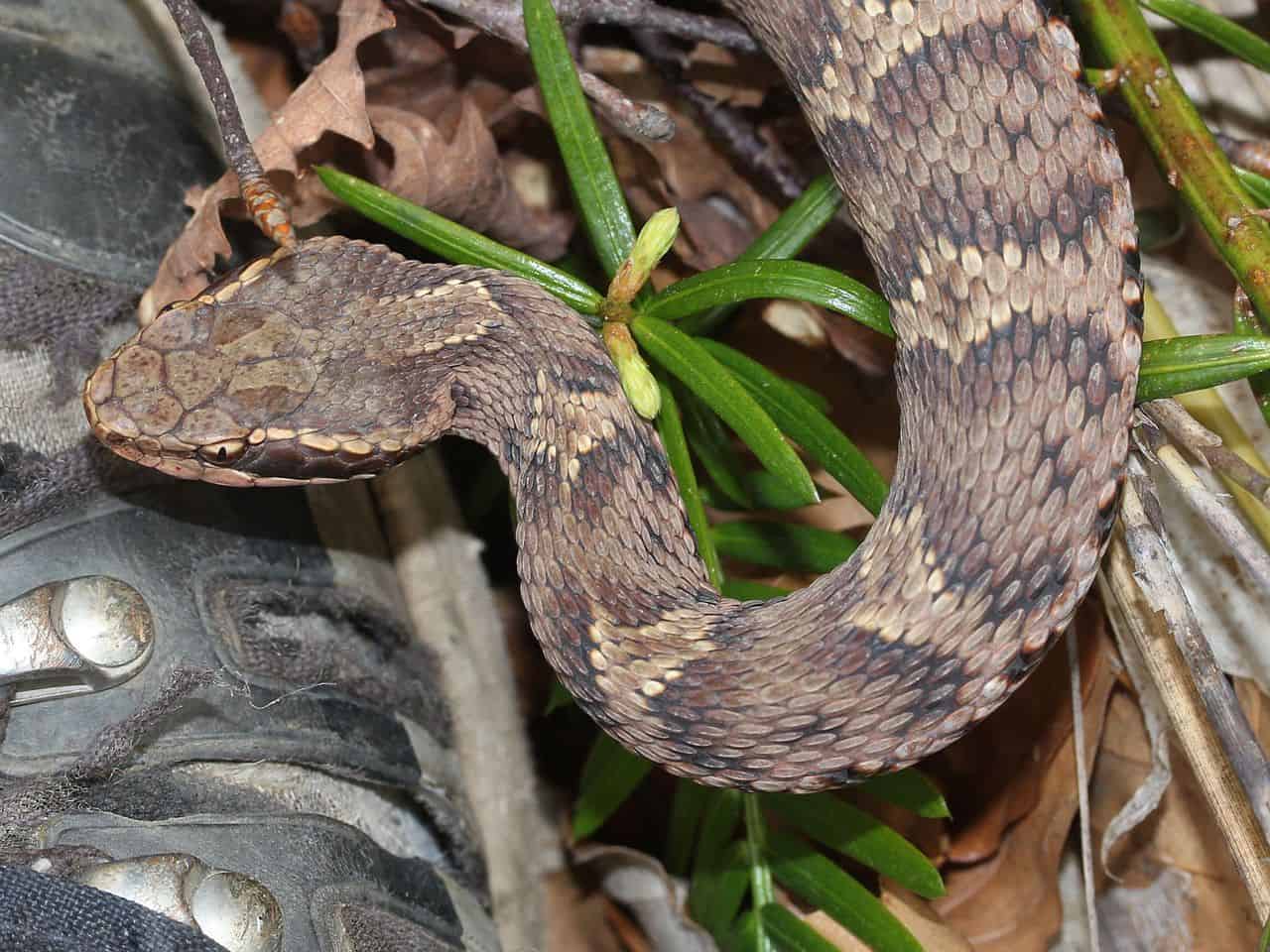
Length: 48-80cm.
Gloydius is a large family of venomous snakes found in eastern Asia, which are most closely related to the Agkistrodon family of copperheads and cottonmouths. There’s 25 members, every species is venomous, and one of the more notorious is the mamushi of Japan. This species inhabits all of Japan, from the main island of Honshu to frosty Hokkaido to the north. They bite hundreds of people per year, killing an estimated 10, and one deadly feature is that people’s internal organs begin to liquefy.
Mamushis have a handful of neurotoxins, but their venom is mainly cytotoxic and haemolytic, attacking skin tissue and causing necrosis. The main cause of death, if it happens, is kidney failure. Spontaneous bleeding is a strong feature of mamushi bites, from the bite wound but also gums and other half-healed cuts.
Mamushis are saved from causing even more terror by their inablity to jump, and that they only attack when victims draw near. Most victims are farmers maintaining their rice paddies and crop fields, or villagers foraging for herbs, berries, and mushrooms, after sifting through long grasses. Mamushis love to camouflage in this long vegetation, blending in. They’re common on the edges of agricultural fields and woodland trails, while rarely appearing in towns. This is a classic village pitviper.
| 2 | Ussuri pitviper |
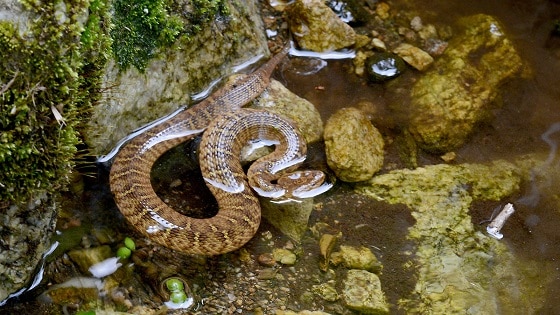
Length: 50-60cm, up to 80cm.
South Korea is a surprising hotbed of venomous snakes, and this is one of three Gloydius pitviper species native to the country. Ussuri pitvipers like forested valley floors, particularly areas close to streams. This is a fairly lazy snake, as a 2015 study from South Korea found that some radiotagged snakes moved just 3-32 metres from their original position in 300 days. Ussuri pitvipers are found in the entire Korean peninsula, as well as a swathe of far eastern Russia and northeast China.
Ussuri pitvipers prey heavily on amphibians, with their favourite species including Japanese tree frogs, Boreal digging frogs and black spotted frogs. A bite in humans results in spontaneous bleeding, swelling, and necrosis.
While lacking in neurotoxins, Ussuri pitvipers attack blood clotting, and do so from many angles. The first is destroying fibrinogen, the substance which directly leads to fibrin creation, the physical backbone of blood clots. A more subtle angle is disabling factor X in the bloodstream. Factor X transforms prothrombin into thrombin, and thrombin is what acts upon fibrinogen to create fibrin. As they like areas closer to villages, Ussuri pitvipers are believed to cause the most venomous snakebites annually in South Korea.
| 3 | Tsushima Island pitviper |
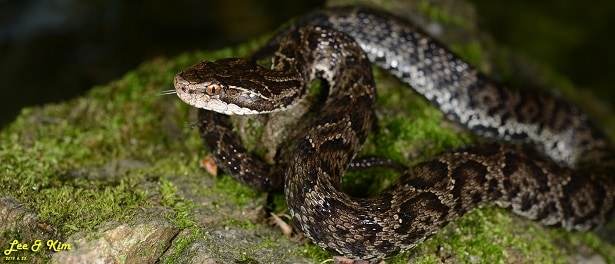
Length: maximum 62cm.
The other Gloydius pitviper on Japanese soil. This version is found on a single island – Tsushima island (population 30,000), which lies at the very southern end of Japan, and is its closest island to the Korean peninsula.
Gloydius tsushimaensis lives in forests, rice fields, and the edges of swamp land, where they feed on shrews and amphibians such as Tsushima brown frogs (Rana tsushimaensis). This menacing viper has orange eyes, and is most heavily sighted in September, when males embark on their annual quest for females.
The mamushi causes 10 deaths per year in mainland Japan, but a 2011 study suggested that Gloydius tsushimaensis is significantly deadlier. Its LD50 dosage (the quantity required to kill 50% of animals) was half that of the mamushi, while its minimal haemorrhaging dosage was just 1% of the mamushi’s. Additionally, the antivenom for the mainland mamushi was only partially effective. Gloydius tsushimaensis has no specific antivenom, and there are no plans to manufacture one. Watch your step if ever find yourself on this obscure Japanese island. Rather than the mamushi, Gloydius tsushimaensis is most closely related to the Ussuri pitviper of South Korea.
| 4 | Short-tailed mamushi |
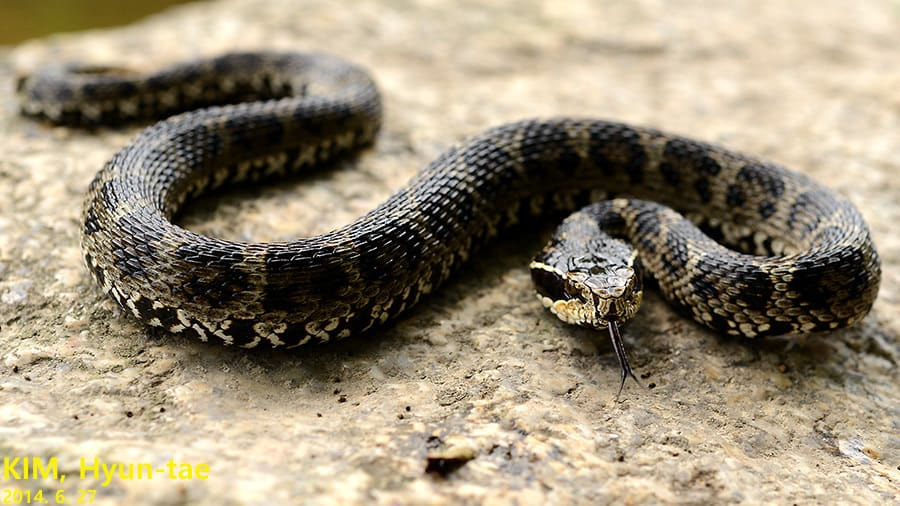
Length: 40-60cm.
The second of South Korea’s 3 Gloydius pitvipers. This species is widespread all over the Korean peninsula, as well as eastern China, where they have a stronghold around Shanghai. Places they don’t appear include Hong Kong, Japan and Vietnam. Rather than rugged mountains, short-tailed mamushis (Gloydius brevicauda) prefer low altitude areas with higher temperature and humidity. This includes agricultural areas, forests, and rivers.
This snake specialises in local skin tissue destruction. According to a 2014 study, 64.4% of adult Gloydius brevicauda venom consists of metalloproteinases, which dissolve amino acid bonds in proteins. This snake has very few neurotoxins. A 16 year old boy who kept an imported Gloydius brevicauda in Hong Kong ended up being bitten on the left middle finger. His left hand rapidly swelled up, and he was admitted to the emergency room, but the boy had no systemic symptoms, such as paralysis, vomiting or faintness. 2 months later, his finger was still crooked when flexed.
South Korea has three Gloydius pitvipers in total, but this species is the one used by national authorities to make antivenom. It’s the usual system: injecting raw venom into horses and collecting the rapidly generating immune system antibodies. Originally, this was considered to be a subspecies of the Japanese mamushi, and was dubbed Gloydius blomhoffi brevicauda. Now it’s been granted full species status, but they’re still each other’s closest relatives within the 25 member Gloydius family.
| 5 | Himalayan pitviper |
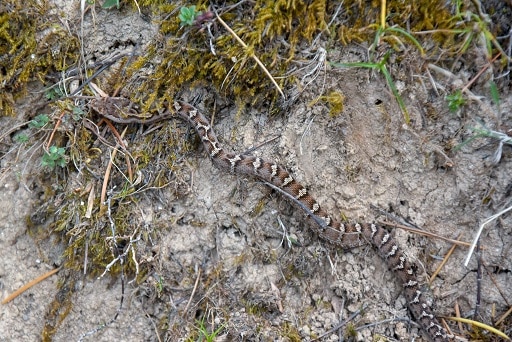
Length: maximum 86cm.
A mountainous pitviper which lives in extremely rugged, remote habitats, but also close to villages in valleys. This is the only Gloydius pitviper found south of the Himalaya, which acts as a titanic barrier to any migrating snake. But there’s a much more interesting record: this is officially the highest altitude snake in the world. Gloydius himalayanus has been found at 4900 metres above sea level, with Nepal and northeastern Pakistan being hotspots.
Everest base camp on the Nepali (south) side lies at 5364 metres, so mountaineers on the ten day trek from Kathmandu could easily bump into this species. Himalayan pitvipers are common in open alpine meadows, and are rumoured to appear at the sides of glaciers. However, Himalayan pitvipers also appear at lower altitudes of 2000-2500 metres, where they roam thick forests.
An aggressive Himalayan pitviper will enter into a strike pose, with its body relatively close to the ground (unlike a cobra). A telltale sign is a neck kinking sharply at a right angle, with the face facing the aggressor (see here). This is also the only Gloydius pitviper found in Pakistan, straying into the mountainous northeast (home to K2). Gloydius himalayanus is an outlier on the Gloydius family tree, with a distant genetic relationship to the rest.
| 6 | Shedao island pitviper |
Length: 60cm.
This Gloydius pitviper is found in just one location: the tiny Shedao island 7 miles off China’s northeast coast. This is a proper island’s island, with steep cliffs and frequent howling winds, and snakes absolutely everywhere.
Shedao Island measures just 0.73 km2, and reaches a maximum altitude of 215 metres. Yet estimates of the snake population range from 10-20,000 individuals. A century ago, before the snake wine industry boomed, the figure was an estimated 50,000. In certain hotspots, this island can contain a pitviper every metre. Their activity peaks in May and September, at which point the temperature is 10-20C.
Winters on Shedao island are severely cold, yet this poses no problem for Gloydius shedaoensis. They have a lengthy hibernation season, deactivating for up to 8 months straight. Most of their diet consists of migratory birds, which dock on the island temporarily, only to face a snake surprise. As these birds are seasonal meals, there’s no point in Gloydius shedaoensis even staying awake for most of the year.
Some birds like the Chinese egret and northern white-rumped swift live on the island permanently, but a further 84 species use it as a migratory outpost, sometimes landing for just a few days. Gloydius shedaoensis has a fun tendency to jump out of trees, although it might not be fun for visiting researchers.
| 7 | Central Asian pitviper |
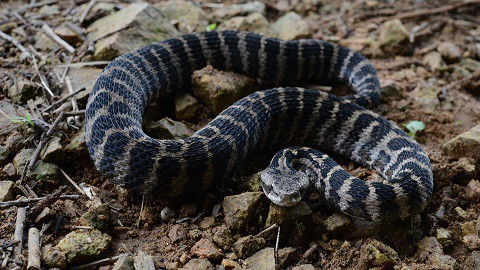
Length: 35-70cm.
The last of South Korea’s 3 Gloydius pitvipers, and the one found most commonly at high altitude. Unlike G. brevicauda and ussuriensis, this species prefers open, rugged mountain fields with minimal tree cover, with sweeping views to admire. Though research is scarce, its diet is heavier in mammals, with confirmed prey including the house mouse and royal vole (Craseomys regulus).
This snake once had a massive empire across central Asia. However, genetic testing has limited it to the Korean peninsula, and an area of far eastern Russia north of Korea. Unlike most Gloydius pitvipers, this species has a strongly neurotoxic venom. A bite can unleash trembling fingers, respiratory failure, twitching eyelids, drowsiness, and variety of brain signal disruption consequences.
One great study compared Ussuri pitvipers and Gloydius intermedius in the same nature reserve (Cheonma-san Mountain County Park), located in South Korea. The verdict was that G. intermedius strongly disliked forests. They never appeared in areas with 100% tree canopy cover, while Ussuri pitvipers were abundant in heavy tree cover. G. intermedius gravitated towards areas of 0-20% tree canopy coverage, while G. ussuriensis was very scarce. The altitudes were highly separate: intermedius stuck to above 600 metres, while the Ussuri pitviper was common in forested valleys below 400 metres. These pitvipers are able to coexist in South Korea because of their completely separate habitat niches.
| 8 | Siberian pitviper |
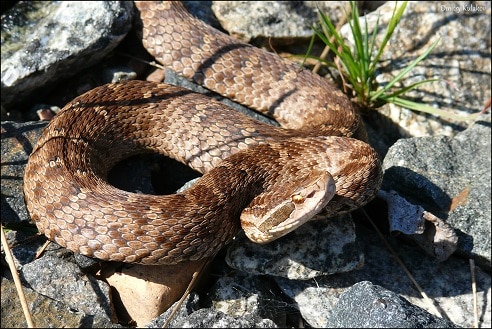
Length: 40-55cm.
A species of rugged realms with few human inhabitants. The Siberian pitviper (Gloydius halys) is the most widespread of its family, ranging from Azerbaijan in the west to Beijing in the east. This title was originally held by Gloydius intermedius, the central Asian pitviper, which was thought to roam Iran, Kazakhstan and northern China. However, recent genetic investigation led to most of these colonies being switched to the Siberian pitviper instead.
This species never appears in flat valley bottoms or dense forests. They prefer rocky upland areas, including the banks of mountainous streams and rugged mountain steppes. This species is especially abundant in the vast wilds of Mongolia, and is missing from Korea, Japan and far eastern Russia. Siberian pitvipers hibernate on south-facing slopes to maximise sun absorption, burying themselves deep underground in twisting burrows, and not emerging for several months.
If a Siberian pitviper sees you, they may consider biting, while also considering the advantages of staying quiet. Given that this snake lives in the middle of nowhere, bites are uncommon. However, its venom is strongly cytotoxic and hemotoxic, unleashing local symptoms like swelling and necrosis. A unique peptide called halysase has been isolated from its venom, which causes the apoptosis of endothelial cells, destroying the extracellular membrane, including a variety of proteins such as type 4 collagen. Another peptide identified cleaved through fibrinogen, a key ingredient in properly clotting blood.
| 9 | Nuijang pitviper |

Length: 60-70cm.
The Gloydius pitviper family is far from done expanding. We’re now into the 20s, and given how vast the steppes of central Asia are, it’s likely that we’ll pass 30 in the next couple of decades. A recent addition was the Nuijang pitviper in 2021, AKA Gloydius lipipengi. This is a Tibetan species which is known from just one location: Muza village, Zayu County. This lies in southeastern Tibet, just over the border with India.
Gloydius lipipengi was found in a hot, dry valley not far from the Nujiang River. The snake was spotted resting on leaf litter in a dry forest, at 9:00am. The scientists only found this one snake, yet it was sufficient to identify it as a new species.
One special feature was a pair of black markings on its head, which look somewhat like two people bowing while shaking hands. Its belly was grey, interspersed with random black squares. Its closest relative was deemed to be Gloydius rubromaculatus, found on the Tibetan plateau 500km away. The snake measured 62.82cm, from head to tail tip. It had a distinctive greyish-brown base of colour, with vivid patterns of interlocking black rings. The new Gloydius lipipengi was whisked away to captivity, where it happily swallowed pink mice.
| 10 | Jiuzhai pitviper |
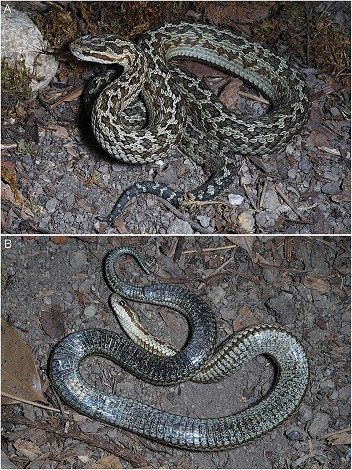
Length: 42.4-53.3cm.
An even more recent discovery came in 2022, from the Jiuzhaigou National Nature Reserve of China. This is an official world heritage site, covering 651 square kilometres, a nature sanctuary where endangered panda bears and golden-snub nosed monkeys can roam freely. Knowledge about reptiles in the reserve was much poorer, so in 2021, scientists embarked on an expedition in which they scooped up several Gloydius pitvipers.
The verdict: they had discovered an all new species, which they dubbed Gloydius lateralis. The species ranged from 42.4-53.3cm, and had a tendency to hang out by hot, sunny roads. A couple were actually found dead on the roads. A brown stripe extending backwards from its eye and continuing along much of the body was a distinctive physical feature. So far, the Zharu valley is the sole known domain of this new pitviper.
Technically, Gloydius lateralis was “discovered” centuries ago: villagers have almost certainly been tiptoeing around it for eons, warning their kids not to walk down a particular trail. Yet it was only identified as a new species in 2022, separate from all other Gloydius members. It was deemed to be most closely related to the glacier pitviper (Gloydius swild). This was yet another new discovery, identified in the same 2021 study as the Nuijang pitviper. Gloydius swild was found in Heishui County, southern China, hiding under rocks on a sunny mountain slope.